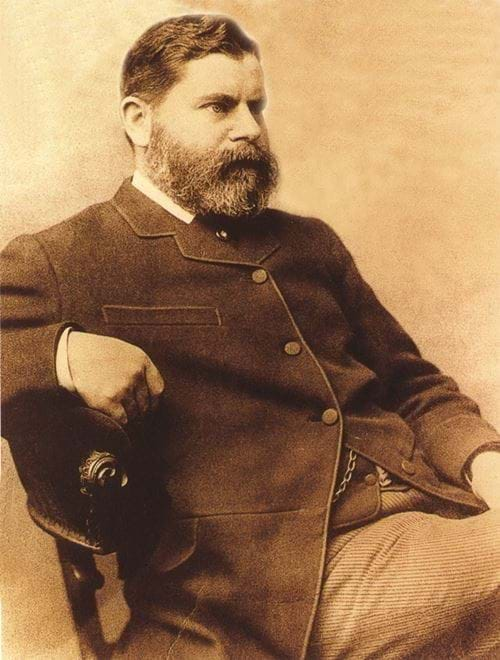Our origins

George E Davis, who is considered to be the ‘father’ of the profession, suggested as far back as 1880 that the group which the following year became known as the Society of Chemical Industry, should be named the Society of Chemical Engineers. Unfortunately this view was not shared by his compatriots and so the idea of forming a new professional body was put on the back burner for a number of years.
Davis continued in his pursuit of chemical engineering and wrote not only the first text book but also gave some of the earliest lectures on the subject in Manchester and started publishing them in 1888.
It was during World War I that the need for a more scientific approach to the problems of chemical plant – its efficiency, design, construction and working – was emphasised. Lord Moulton (after whom the Moulton Medal is named), who was then Director General of Explosive Supply, insisted on the necessity of training “Chemical Engineers” and thereby foreshadowed the founding of the Institution.
As a consequence of Moulton’s pressures an influential body with opinion was developed in the UK in favour of some action by which the study of chemical engineering could be encouraged and given some place in the educational system.
On 29 July 1918, a meeting was called by Professor J W Hinchley, the first Honorary Secretary of the Institution, and about 70 gentlemen met under the chairmanship of Professor G T Morgan and decided to form, if it were possible, a subject group of the Society of Chemical Industry to be called “The Chemical Engineering Group”. This Group was formed on 20 October 1918 and subsequently studied the art and science of chemical engineering and promoted chemical engineering vigorously.
A separate qualifying body of chemical engineers should be set up
At the same time a number of practising chemical engineers were of the opinion that a separate qualifying body of chemical engineers should be set up and according to Norman Swindin, approaches were made to the Institution of Civil Engineers and the Institution of Mechanical Engineers to see if they would sponsor a specialist group for chemical engineers within their Institutions. They turned down this suggestion and in 1919 a number of professional chemical engineers continued to call for a separate Institution which could act as a qualifying body.
In July 1920, during the Fourth Conference of the Chemical Engineering Group of the Society of Chemical Industry, a meeting was held to promote the formation of an Institution of Chemical Engineers. In 1921 some of the supporters of the idea of a professional qualifying body in chemical engineering stated that unless active steps were taken by those who helped to found the Chemical Engineering Group, then a qualifying institution for chemical engineers would be founded in the North of England.
The idea was widely aired and a meeting was called by Professor Hinchley on 9 November 1921. At this meeting a resolution to form a provisional institution was moved and carried unanimously, as was a further resolution to elect a Provisional Committee.
The enthusiasm for the idea of a professional qualifying body in chemical engineering was so great that six of those attending the meeting promised £100 each towards the expenses of forming a professional qualifying body for chemical engineers and other promises of subscriptions of considerable weight were also made.
Meetings of the Provisional Committee took place at frequent intervals and as no established institution met the needs of chemical engineers it was agreed that the Institution of Chemical Engineers should be constituted.
In March 1922 an Advisory Committee was formed consisting of those interested in offering suggestions on the constitution of the Institution, and the proposed Memorandum and Articles of Association of the newly conceived Institution of Chemical Engineers were sent to a number of societies for comment.
The proposed Memorandum, Articles of Association, and By-Laws of the proposed Institution were then duly approved
The proposed Memorandum, Articles of Association, and By-Laws of the proposed Institution were then duly approved and it was agreed that seven members of this Provisional Committee be elected to sign the legal documents.
An inaugural meeting of the new Institution of Chemical Engineers was held on Tuesday 2 May 1922 at the Hotel Cecil, London and a Selection Committee was appointed by ballot to report to the Provisional Committee. About 100 people attended the Inaugural Meeting when the Honorary Treasurer, Mr F H Rogers, was able to announce that £1425 had been guaranteed and that further donations were still being received.
A number of objections were subsequently raised by cognate bodies but following negotiations the Board of Trade informed the solicitors handling the new Institution’s affairs on 18 September that it was prepared to entertain the application for this new body and on 21 December 1922 the Institution of Chemical Engineers was formally incorporated.
The first meeting of the Provisional Council was held on Wednesday 10 January 1923. At this meeting it was unanimously agreed that Sir Arthur Duckham KCB MICE be elected the first President of the Institution. The Provisional Council of the Institution then elected 61 Members and 20 Associate Members. Mr W J Woolcock was elected the first Honorary Member in appreciation of the work which he had done in helping to found the body and acting as Vice Chairman during the heavy work of drafting the Memorandum of Incorporation, the Articles of Association and the By-Laws. The seal of the Institution, designed by Edith Hinchley, was also approved by the Provisional Council.
A number of further meetings of the Provisional Council were held and it was decided that the first Corporate Meeting of the new Institution should be held on 14 March 1923 to comply with the Memorandum and Articles of Association, followed by the First Annual Corporate Meeting on Friday 8 June 1923.
Extracted from “The Chemical Engineer”, April 1972.